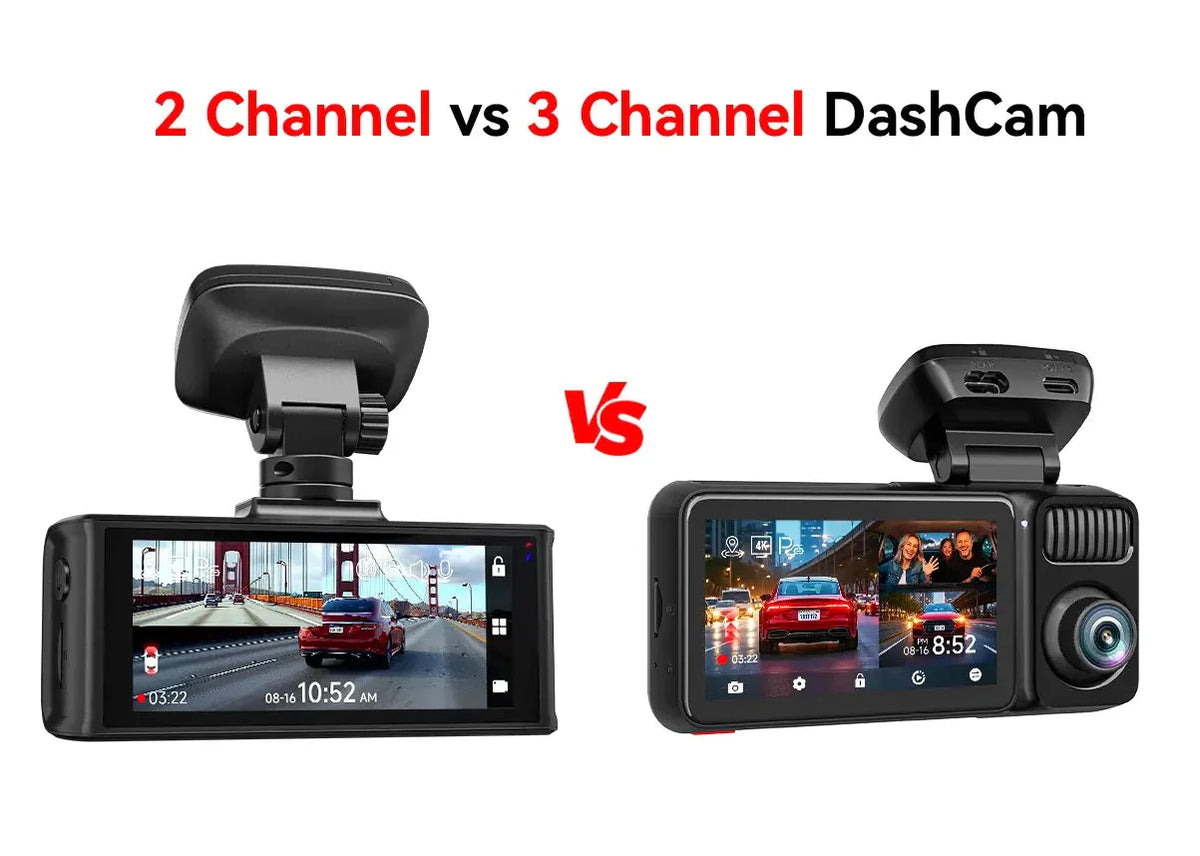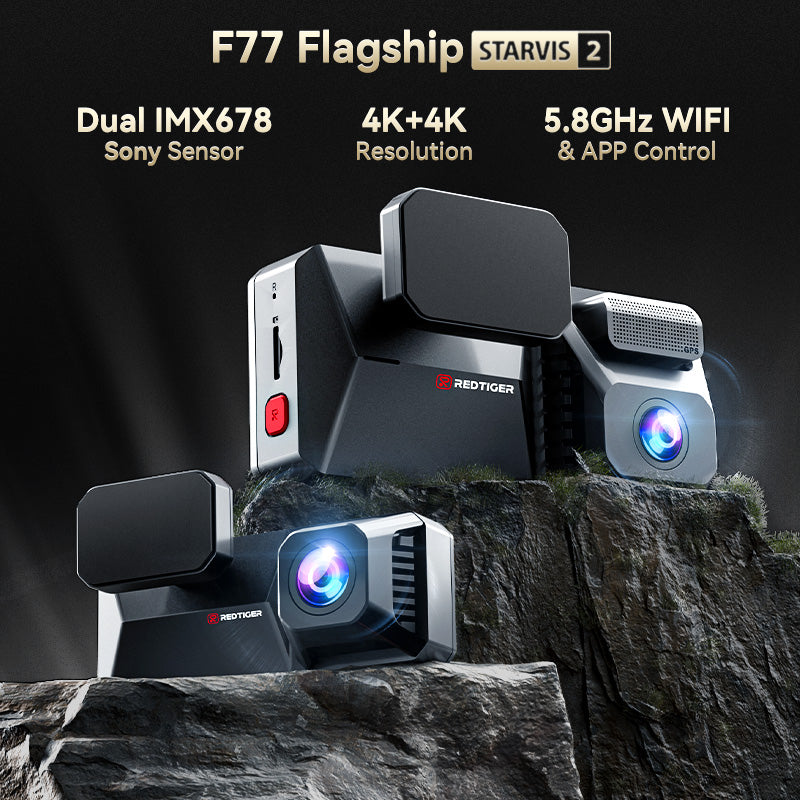

Choosing between a 2-channel vs 3-channel dash cam can be difficult, and this is more concentrated when there are different products in the market. It does not matter whether you're a rideshare driver, a parent with a teenager, or even someone who would like more safety on the road. It is essential to know about these dash cam settings.
At this point, it is time to take a closer look at the specific differences between these model setups and which one of them could be most suitable when it comes to your vehicle.
What Are Dash Cam Channels?
Before we get into 2-channel vs 3-channel dash cam discussion, it is useful to understand different types of dash cameras based on the number of channels. In simple words, a dash cam 'channel' refers to the number of cameras included in the dash cam system:
2-channel dash cam:
A 2-channel dash cam has two cameras, one at the front and one at the rear. This configuration provides extensive coverage, helping drivers record essential information in the case of accidents or disputes. It is best suited for personal use, where it still offers the necessary level of protection and assurance without interior monitoring.
3-channel dash cam:
A 3-channel dash camera includes a cabin-facing camera, a front camera, and a rear camera. Infrared night vision is also found in the interior camera, which ensures it records without any clutter in dim lights. This added security would be most appropriate to a rideshare driver, a taxi company, or a parent with a teenage driver.
Knowledge of these dash cam channels enables drivers to find the most suitable extent of observation according to personal or commercial requirements, so that no angle is left uncovered.
How 2-Channel Dash Cams Work?
Before going even further, we must talk about how 2-channel dash cams work.
2-channel dash cam consists of:
- Front Camera: Installed on the windshield, capturing all that is on the road ahead.
- Rear Camera: They are typically mounted on the back window, and they record traffic behind you.
A 2-channel dash cam is so built as to capture both directions, the front and the rear of your vehicle. The front camera can be used to capture the current situation on the road, record road traffic patterns, traffic lights and alarming situations. It is mounted on the windshield and provides high-quality shots that can be viewed as evidence in case of insurance claims or in the legal matter.
The rear camera is most commonly placed on the back window or license plate area, and monitors traffic behind you. This becomes necessary to capture evidence in the event of a hit-and-run or rear-end collision.
How Do 3 Channel Dash Cams Work?
In case you are seeking a higher security level and comprehensive protection in your driving, investing in a 3-channel dash cam is the most efficient and smart choice available today.
3-channel dash cam consists of:
- Front Camera: It records clear images of the road ahead that capture the traffic situation and possible dangers, accurately.
- Rear Camera: It tracks the traffic behind your car, capturing events of reversing or any unforeseen impacts.
- Interior Camera: It includes the cabin space, which is perfect to keep the passengers secure in the taxi, rideshare, or within a family.
Unique Features:
- Infrared night vision: The interior camera usually possesses infrared LEDs to capture a clear video at night or in low light conditions.
- Simultaneous Recording: All three cameras record simultaneously, providing you entire picture of the environment.
The 3-channel dash cam supplements the automobile security further by including an internal camera to the setup in addition to the ones on the front and back. It has an in-built triple-channel, records a full 360 view and is ideal to all personal and professional drivers.
What is the difference between a 2-channel and 3-channel dash cam?
In the comparison of 2-channel vs 3-channel dash cam, the fundamental difference is in coverage scope and use case.
Coverage:
- 2-Channel Dash Cam:
2-channel dash cam has front and rear coverage, and the camera angles give the user a view of the road ahead and behind traffic. It is best suited to daily commuters with the need to have basic external coverage in case of accidents or incidents.
- 3-channel Dash Cam:
The 3-channel dash cam adds cabin monitoring to the front camera and rear camera functions, offering complete 360-degree coverage. It is best suited to rideshare drivers, taxi companies, or parents desiring to track activities inside the car alongside road experiences.
Storage & Power:
- 2-Channel Dash Cam:
A 2-channel dash cam has an average storage capacity and power consumption. A 64GB to 128GB SD card is just enough to manage day-to-day recordings without overloading the data needs by increasing battery load or hardware demands.
- 3-channel Dash Cam:
The dash cam with 3-channel recording requires increased storage and power consumption in comparison with two-channel recorders. It is recommended that 128GB to 256GB SD cards be used with hardwiring kits to have continuous and reliable video recording and power.
Installation Complexity:
- 2-Channel Dash Cam:
Super easy to install with the minimal wiring required and a user-friendly option does not require any technicians. The process of installation of the front and rear camera is simple, less time and less experience is required, as compared to the advanced setups.
- 3-channel Dash Cam:
Installation is more complicated and involves detailed wiring of the interior camera. In some cases, professional installation is better to exclude improper positioning, sloppy installation, and the perfect integration to make the most out of it.
Also see: Dash Cam Install Cost
Which One Should You Choose?
The choice between a 2-channel vs 3-channel dash cam will always be determined by your individual driving needs and safety concerns. That can be simplified by the following guideline:
Choose a 2-Channel Dash Cam if:
- You need the assurance of front and rear protection for everyday driving.
- Your main concerns include possible accidents, a parking situation, or a rear-end collision.
- You don’t need to monitor the vehicle’s interior.
- Budget is a consideration, and you want a less complex installation.
Choose a 3-Channel Dash Cam if:
- You require in-cabin recording to observe passengers or drivers.
- You are a rideshare driver (Uber, Lyft), a taxi operator, or a fleet manager.
- You have teen drivers or family members and want additional accountability.
- You desire ultimate protection that includes comprehensive footage from in and around your vehicle.
Comparing your requirements to these possibilities, you will be able to choose the dash cam system that offers the right balance of protection, features, and value.
Also see: The Best Dash Cam for Teens
Leading Models Compared
Now that you understand the differences and advantages of 2-channel vs 3-channel dash cam, let’s explore some of the best-performing dash cam models available to help you make an informed choice.
REDTIGER F17 Elite:
The REDTIGER F17 Elite is a premium 3-channel dash cam supporting 4K ultra-HD front recording, 1080p recording of the rear and interior cameras. It also hosts features of GPS tracking, full-color night vision for enhanced low-light detail, Wi-Fi connectivity, and parking mode. Making it an excellent choice for rideshare drivers or fleet managers who need to have comprehensive, all-around vehicle protection and passenger supervision.
REDTIGER F77:
The REDTIGER F77 is a high-performance 2-channel dash cam that records in true 4K UHD at both the front and rear, delivering ultra-clear video coverage from both angles. It includes GPS tracking, loop recording, and Wi-Fi connectivity for seamless data access. With its dual 4K cameras, the F77 is ideal for everyday drivers seeking unmatched video clarity and reliable front-and-rear protection without the need for interior monitoring.
Other Brand Models:
Among the popular options, there is the Vantrue N4, a 3-channel dash cam with a 4K front and 1080p interior and rear cameras appropriate for rideshare safety. Viofo A129 Duo is a trusted 2-channel camera with good front-rear recording, GPS, Wi-Fi, and motion detection, ideal for everyday drivers seeking simplicity.
Conclusion
Choosing between a 2-channel vs 3-channel dash cam solely depends on your driving needs and desired level of security. Whether you seek basic protection or comprehensive monitoring, investing in a quality dash cam is a necessity.
Redtiger dash cams are trusted for their outstanding quality, modern features, and reliable performance, making them a smart choice for any driver focused on safety and peace of mind.
FAQs
What is the best option for a dash cam?
The ideal dash cam depends on your requirements. To drive in general, a 2-channel dash cam is sufficient. A 3-channel dash cam is preferable to cover everything comprehensively.
Do I need a 2 channel dash cam?
Yes, in case you need front and rear protection. It is very important in proving cases of accidents.
Is a 3 channel dash cam necessary?
A 3-channel dash cam is necessary for rideshare drivers, families, or fleet vehicles. It provides complete visibility, capturing the front, rear, and interior of your vehicle simultaneously.
What is the best 3 channel dash cam?
The REDTIGER F17 Elite model is highly recommended for its reliability, advanced features, and comprehensive road and cabin protection.

